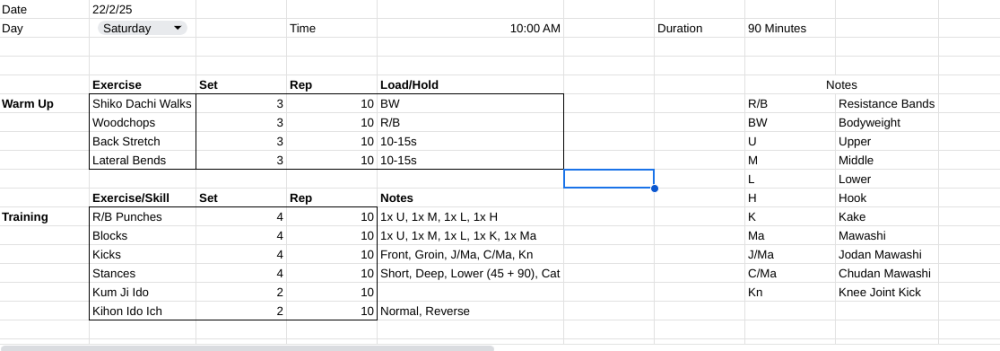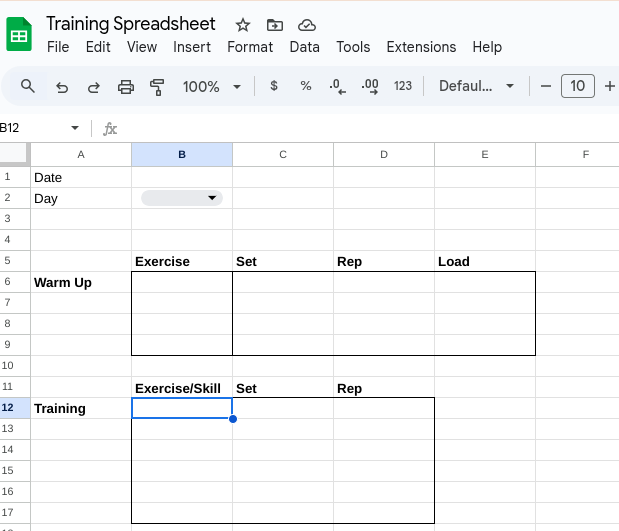
Nidan Melbourne
KarateForums.com Sempais-
Posts
2,543 -
Joined
-
Last visited
About Nidan Melbourne

Personal Information
-
Martial Art(s)
Goju-Ryu, BJJ, Balintawak Arnis
-
Location
Melbourne, Australia
-
Occupation
Student
Recent Profile Visitors
The recent visitors block is disabled and is not being shown to other users.
Nidan Melbourne's Achievements

Black Belt (10/10)
-
Ergo Sensei8 is an Advanced Form (Life Form that is hehehe). I am a Beginner Form (relatively) hahaha
-
Thank for the post @Revario! Great questions! To me; a "Beginner" Level Kata is one that has maybe 1 or 2 concepts in them for students to understand or to be introduced to. For instance; Taikyoku Jodan (The first Kata in Goju-Kai if used) introduces basic manouevring from Sanchin Dachi to Zenkutsu Dachi and turns (180 + 90 degrees). But to be fair there would be some Intermediate Levels also which lays somewhere in between Beginner and Advanced. However, the ones I mention here are often the first taught at many Goju-Ryu Dojo. So Gekesai Dai Ichi and Ni along with Saifa would be my Intermediate forms. "Advanced" Level same idea as the Beginner Level; however contains more concepts. So for the Goju-Kai Syllabus; I'd say Seeiunchin or Sanseru would be the start of the Advanced Forms. However, it can be a tad subjective because each club may approach kata difficulty differently. Like I have the Gekesai as Intermediate, yet others it would be a Beginner level. Yet whats funny, is when I have students take a step back and view the kata as a whole then go to break it down. Because to me even the Beginner Kata can provide you with tid bits that can become quite practical for Self-Defence Routines. There has been some discussion around a specific kata being the Styles "Signature" Kata. Sanchin being Goju's Signature Kata. When I discuss it with other Black Belts; often who are far more experienced than myself. A common theme comes up that learning it is delayed or revealed when the student is ready to learn it. If the Styles "Founder" placed importance in one kata, then in my mind that kata must (in a way) contain the knowledge that makes their style. Which when I look at Goju-Ryu (even my Goju-Kai), Sanchin blossoms into a large foundation of knowledge that the techniques taught can easily be performed there. The masters when they were creating their kata, would have to contain a piece of knowledge to help students. At the moment, I feel the closest to either Gekesai Dai Ich or Seisan. Gekesai for its simplicity but also in its viciousness and straight up slapping the person (IYKYK). Seisan for all those sweeps that are included in several different forms.
-
Adding both qoutes here so others know what I'm referring to. I have actually been attacked from behind several times. And one of those times was from a bear hug. Thankfully I am an oddball as a student and instructor, so it is something that I teach students to work through so they know what to do. And I live in Australia! As Bearhugs for adults may not be a common attack, but for kids/teens it is a very real risk of happening. So Karateken has a point, where body punches as your only tool is redundant. This is where a lot of clubs I've noticed at least, don't exactly give students the tools to work with. But just reading that post from Karateken reminds me of my time at High School, where that was a common thing for some bullying. WHen you lose the ability to use your arms to their fullest; you realise what tools you do have despite the amount of panic that may be going on.
-
To be honest with you, I haven't met anyone (In Person) who teaches or has students to perform or learn "Complicated" Self-Defence Routines or Techniques. When I was a 1st Kyu; I had to create 10 Self Defence Routines from Saifa Kata. Every Instructor I had at the time reminded me of the KISS Principle, which is simple enough to remember but more importantly easy to perform on all different people. Even now as a 2nd Dan, I am dissecting Seisan Kata (Goju-Ryu Version) the longest routine I have is reacting to multiple attacks from a single attacker. In which it is probably a max of 10 odd techniques/movements. But I have seen my fair share of "Complicated" Techniques online, none of which I will share here. Because I don't want to disrespect those doing the work, and also because I haven't trained there to get the proper explanation as to the how and why. Contentious. Physiologically, you can deliver Full-Power Strikes but there is a limit to how much people to can deliver before lactate builds up. Thats why you often see UFC Fighters shaking their arms onces they disengage. As they are trying to get the lactate and other chemicals that build-up out of their arms. Everyone has a limit of full-power techniques they can deliver before they need to rest and recover. Thats why when your pushing yourself hard, you get that "burn". Exactly, regardless of the divisions available; I'm always in the heavier division due to my current weight. Yes, I might get outmanouvred by lighter opponents but at the same hand having fought heaver opponents for the last few years has taught me how to hit appropriately against a bigger person. I don't want to hurt anyone in competition due to them being 100kg lighter than me.
-
Drifting away, lapses in training
Nidan Melbourne replied to crash's topic in General Martial Arts Discussion
I've only had 2 major interuptions to my training, and 1 short term interruption. My short term interruption was surgery I had on my knee in 2004; so I had to take some time away from training to let myself heal and recover before returning. My first major interruption; was in 2010 when I was in my final year of school. I had to focus on my studies and had a heavy workload due to extra-curricular commitments that were a requirement set forth by the school. But to be honest with myself; I also in part lost interest I training because of life and was wanting to spend time with friends and my then girlfriend all whilst completing school and doing my extra curricular stuff. My second major interruption is actually occurring right now; as I just had my divorce finalised. But also dealing with Mental Health Issues and also have a existing court related issue that I am currently in the process of dealing with. So I had to step away from the dojo to focus on all of that. -
My Shihan, has a couple of Punching Bags that hang up along with a few dumbbells and other pieces of exercise equipment that live near the front desk. We use the bags to allow students to go full force in the bags (Adults Mainly), as it is far safer to do so on those than it would be to go full contact all the time on partners. ALthough we also do run Exercise Classes that use them and use the mat space for various exercises.
-
Aaaaaaaand this is when I jump in; I understand your frustrations around some rigidity or how some styles of karate (or other arts) fight in the dojo for Health and Safety Reasons. This is where as a Shodan; you should already have an an idea of the WHY around why they may want you to do spar in a certain way. But seems like you haven't broken the rules to find what actually works for you in terms of kumite. For instance; I am a 2nd Dan in Goju-Ryu. Do I spar anything like other Goju Practitioners? - Absolutely not, I fight somewhere in between a karateka and a boxer. Is it evolving as i learn more? yes it will I understand that it may be a high learning curve. but depends on how you train outside of class. Although I do question how your teacher explains the concepts and at what rank they do so. By that I mean that I explain say Zenkutsu Dachi and minor details very differently to a 9th Kyu (White Belt) vs. how i explain it to a Shodan. Or are you talking about the learning curve once you were promoted to shodan? Also a "Good" Fighter is separate to what you may do in the dojo itself. In Tournament Situations; it is very much about experience and how you train and learn. However in Self-Defence situations; it is a different situation because everyone reacts differently. But being a "Good" fighter seems like you would seek out fights to prove that your better than someone else. From my experience in Cross-Training; I found that Simple is often more effective than something that overloads you with information. So I learn Balintawak Arnis (GM Bobby Toboada started this), where you progressively build up to Level 6 (Completion of the Art/Black Belt Equivalent) then Level 7 (Fully Qualified Instructor). Level 1 you learn the basics, then as you progress up each level you review the prior levels (and demonstrate competency showing you have improved). By the time your doing your Level 7 Examination; your demonstrating Levels 1 - 6 you are a competent person who can/should react at full speed. I understand the want to prepare students psychologically, as to be able to deal with being hit. But things do change quickly when you are punched in the face without gloves. Bareknuckle Boxing back in the day, was definitely the norm as that's how a lot of arguments were resolved back well before any of us who are savvy enough to use a computer were born. I know full well my grandfather most likely settled a lot of fights back when he was a young lad before immigrating from the UK to Australia in the 60's. Considering how nearly all young men served in some way shape or form in the Armed Forces throughout the world around the 1920's-30's. So Violence was the norm, and being hit the face wasn't nearly as much of an issue as is it is today. Because back then our equivalent of being punched the face back then was being shot and killed. Like others have said; to have proper full-contact sparring regularly, you either need to have really good insurance OR have students sign waivers not holding the club liable for injuries sustained in the course of their training. From what I've gathered from your post; your looking at doing full contact all the time. But the one thing I have learnt, is that no matter how much you condition your muscles through repeated trauma can cause a lot of issues later on. Unfortunately there hasn't been much research the long term damage or health concerns; as not many people are researching Martial Arts in the Health, Exercise or even Sports Disciplines. This is in the form of those of whom have passed away and we see what has occurred to the body after a lifetime of training. Now Abdominal training can only go so far for each person, before the damage accrued just leaves the person at a higher risk of trauma as the body wouldn't have the ability to recover. I have some friends that have trained in Kyokushin for a long long time; and they have found that they have had a lot of issues around their internal organs because of the amount of trauma that they had faced during their training. But with the amount of training that modern day instructors have, and their ability to help students with post-training recovery which may help with the reduction in long-term complications. And this varies greatly from each Martial Art and how the person trains; of which varies greatly for those who train for Competition vs. those who train for their own enjoyment. The Psychological side of things; I won't fully comment on because I am not trained in Psychology. Nor are (I assume) the majority of people who comment here. But Experienced instructors do learn a lot of tools that are psychology based.
-
April Fools! Oss/Osu Isn't Required!
Nidan Melbourne replied to Patrick's topic in KarateForums.com Announcements
Thanks for the shoutout @Patrick -
Hope your hunt finds you well and hopefully Google is your best friend. Have you spoken to your Renshi about recommendations of where you and other students can go and reach out to? Like I know my Shihan were to close, he would recommend clubs in the surrounding areas that were good and had similar standards. As he wouldn't want to let any of his students down in the training front.
-
I was having a chat with an American Friend of mine the other day, about different sports around the world and then shared sports that various countries play and their respective leagues. and how some sports barely exist in others. What Sports do you follow, that are outside of your own country? He had to get reminded that the "national" sports in each country might not exist in another country or has a small % of participation. When he asked about the Major Sports in Australia; where we have - Australian Rules Football (AFL) [Mens League is well over 100 Years Old, Womens League was created in the last 10 years]. Our primary national sport - Rugby Union + Rugby League - National Basketball League (NBL) - Soccer (European Football) - A-League (Mens League) and W-League - Cricket We have small participation amounts in sports like Ice Hockey and American Football. Before you ask why we don't have larger amounts of Ice Hockey participation. It is because Australia as a whole is a very hot country, even with our seasons; it can vary from 2-3c (~37.5F) to 50c (~122F). SO it would cost significantly more to keep Ice Hockey Centres at a low enough temperature to prevent the ice from melting and to keep it as a playable surface. Then American Football - is already similar to Rugby Union, Rugby League and our own AFL. So there is a smaller following of the sport in relation to being a player, however there does seem to be a decent following in terms of viewership. Although what was funny, is that he had no idea about what AFL was (understandably) so I told him to watch the attached video to get an idea of what it is. And btw Handballing you "punch" the ball from your hand, similar to the first couple steps of Saifa. Restarts after scoring, take less than a minute to do. International Sports I watch (when I can); - NBA (America) - Euroleague (Europe) - Rugby Union - Rugby 7's
-
This was part of my morning training from yesterday, I did add that note section just in case I forgot what shorthand I used also I knew that if I shared I could make it easy to show you guys.
-
The most eccentric karate sensei/dojo/style you encountered?
Nidan Melbourne replied to Himokiri Karate's topic in Karate
Can't say that I have met anyone like that in my 20 odd years of training. But it does make me think about my early days. -
So this is my Template I use to help plan out my training, then just print it off for me to go. I have a secondary sheet on the same document; which helps me keep track of how often I do each of the exercises/skills. Now on both Sheets I have - Exercise Now this is the most obvious thing for the Warm Up and Main Training. You just have to identify what your doing - Sets How many Groups of Repetitions you have to do. - Reps How many times you do it - Load This might sound strange, but if I am adding any form of weight for a Set I add it here. If unloaded; I either leave it blank or write 0. - Skill Type Whatever form of training area that item is. Kihon, Kata, Pre-Arranged Sparring, Breakfalls etc. I'm looking at making another sheet that gives me a tally of how many of everything that I have done. So at the end of a training phase, or when I review my training I can clearly see how often I do everything.
-
Training on Different Surfaces
Nidan Melbourne replied to Nidan Melbourne's topic in Instructors and School Owners
I should probably add, when it came to Throws and Breakfalls Training we had to be careful and limit to more advanced students when it came to training on Wooden Floors. Like I learnt how to fall on Wooden Floors; did it suck? yes it did. But definitely made me appreciate that having those "golden' rules when it came to learning how to do them and also teaching others. Throws are the same, as each throw has different mechanics to them; we had to have solid awareness of what is on the ground and what the surface is like. -
You're doing great! Take it one day at a time. I have a little training diary that I make sure I do something everyday and fill it out.







